In the modern "J horror" ghost stories that have gained international popularity in the last decade, many feature horrific female ghosts (as in the Tomie shocker series), often with a sentimental streak though the sympathetic ghosts are nevertheless deadly (as in certain episodes of the wildly popular Ringu series). This is no recent development in Japanese cinema, as the sinister girl ghost has been around since the Tokugawa period in Kabuki theater, & doubtless much longer than that in folklore. The sympathetic though vengefully demonic female ghost had already entered into the cinematic lexicon in the silent era.
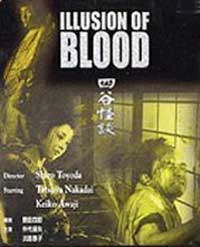 Period ghost stories are an important genre in Japanese cinema. The conventions of the genre are inherited from traditional storytellers & folklore classic kabuki plays, most famously Tokaido yotsuya kaidan by the classical kabuki playwright Namboku Tsuruya IV (1755-1839), in which a horrific & pitiful murdered woman returns to avenge herself against her cruel husband. This was standard summertime entertainment in the late Tokugawa period, intended to "chill" the audience during the hottest days of the year. Period ghost stories are an important genre in Japanese cinema. The conventions of the genre are inherited from traditional storytellers & folklore classic kabuki plays, most famously Tokaido yotsuya kaidan by the classical kabuki playwright Namboku Tsuruya IV (1755-1839), in which a horrific & pitiful murdered woman returns to avenge herself against her cruel husband. This was standard summertime entertainment in the late Tokugawa period, intended to "chill" the audience during the hottest days of the year.
In Shiro Toyoda's gory Illusion of Blood aka Yotsuya Ghost Story (Yotsuya kaidan, Toho, 1965) stars Tetsuya Nakadai as Iyemon Tamiiya, a samurai who discovers that his father-in-law intends to sell Iyemon's wife Oiwa (Mariko Okada) & her sister Osode into prostitution, so kills him & hides the crime. But when Iyemon finds himself in the way of making a more profitable marriage aliance, Oiwa becomes a problem. Conspiring with the family of potential new wife Osode (Junko Ikeuchi), an attempt to poison Oiwa causes her to become hideously disfigured, & the horrified Iyemon kills her & her maidservant.
When Oiwa & her servant return as vengeful ghosts, Tatsuya Nakadai with his big eyes simply has the perfect face to play the haunted Iyemon. The sets & cinematography are highly atmosphjeric. It's slowly paced instead of totally action-packed, so don't go into it for the few moments of samurai action, but enjoy the costumes, sets, acting, moodiness, & Oiwa's ghostly return.
In addition to Toyoda's bloodletting version, numerous directors have tackled this tale, from the silent era onward. Daisuke Ito's silent Yotsuya Ghost Story New Edition (Shinpan yotsuya kaidan, Nikkatsu, 1928), starred Matsumoto Taisuke as Iyemon, & Fushimi Naoe in a double role as Oiwa & Osode.
Other silent versions include Inoue Kintarou's Irohagana Yotsuya kaidan (1927), Nakagawa Shirou's Tokaido Yotsuya kaidan (1927), a version by film pioneer Shozu Makino from 1912, & over a dozen others.
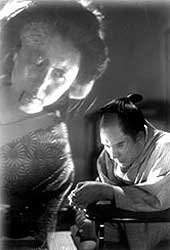 The majority I would guess do not survive. Except for Daisuke Ito's film, most of the silent versions would have, in any case, provided only a few pictorial clues for the benshi (silent film narrator) who presented these films to convey their own storytelling prowess. The majority I would guess do not survive. Except for Daisuke Ito's film, most of the silent versions would have, in any case, provided only a few pictorial clues for the benshi (silent film narrator) who presented these films to convey their own storytelling prowess.
Benshis were for some while such popular entertainers that the films took second status, & directors dared not make the films stand-alone or so specific that a benshi's personal version would no longer fit the visuals on the screen.
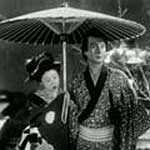 Furumi Takuji directed an early talkie version in 1936 & Onoe Eigorou directed another in 1937. Furumi Takuji directed an early talkie version in 1936 & Onoe Eigorou directed another in 1937.
Keisuke Kinoshita's two-part, political version Yotsuya Kaidan (Shochiku, 1949) managed to delete the ghost for a "realistic" interpretation with neither action nor much in the way of a ghost.
Kinoshita's film stars Ken Uehara as a largely sympathetic Iyemon, & Kinuyo Tanaka as Oiwa. The famous tale is reconfigured as a story of disfigurement, murder & blackmail, with lots of eeriness but no literal ghost.
It is so well photographed & acted that it nevertheless sustains interest. Two black & white stills are shown here, with scarred Oiwa overshadowing her husband in the first still.
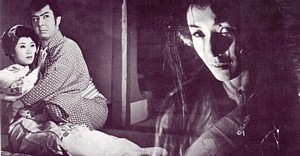 Keisoke/Masaki Mori's Tokaido Yotsuya kaidan (Shin-Toho, 1956) features Tomisaburo Wakayama, best known as Itto Ogami of the Babycart movies. Keisoke/Masaki Mori's Tokaido Yotsuya kaidan (Shin-Toho, 1956) features Tomisaburo Wakayama, best known as Itto Ogami of the Babycart movies.
Wakayama stars as the haunted samurai Iyemon, & Chieko Soma is the hideous ghostly wife, against whom Iyeomon's mother conspired, so that her son could marry Ume of a wealthy family.
The depth of Iyemon's madness is intensified in this version, as he ends up driven to psychosis & hunted down by village peasants like a rabid animal (or like the Frankenstein monster). Wakayama drew on exaggerated kabuki traditions to make the Ieyomon rather over-the-top by the end.
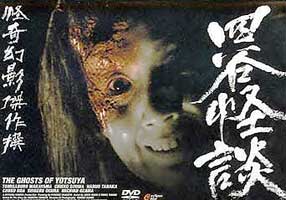 Tomisaburo Wakayama starred in yet another version, Ghost of Oiwa (Kaidan Oiwa no burei, Toei, 1961), with Fujishiro Keiko as Oiwa. Directed by Yasushi/Tai Kato, this is one of the most vile & brutish evocations of Iyemon's character. Tomisaburo Wakayama starred in yet another version, Ghost of Oiwa (Kaidan Oiwa no burei, Toei, 1961), with Fujishiro Keiko as Oiwa. Directed by Yasushi/Tai Kato, this is one of the most vile & brutish evocations of Iyemon's character.
The hideous ghost of Oiwa in this Tai Kato version is shown in this lobby placard. The still immediately above that is for the 1956 Maskai Mori version.
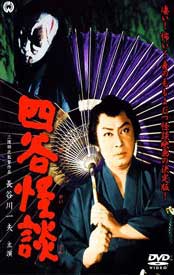 Top directors Kenji Misumi & Nobuo Nakagawa did their versions in the same year, the former starring Kazuo Hasegawa (Yotsua kaidan, Daiei, 1959) & the latter starring Shigeru Amachi & Katsuko Wakasugi (Tokaido Yotsuya kaidan, Shin Toho, 1959). Top directors Kenji Misumi & Nobuo Nakagawa did their versions in the same year, the former starring Kazuo Hasegawa (Yotsua kaidan, Daiei, 1959) & the latter starring Shigeru Amachi & Katsuko Wakasugi (Tokaido Yotsuya kaidan, Shin Toho, 1959).
The Kenji Misumi black & white version, originally released in the US as Thou Shalt Not Be Jealous, cleans up the character of Yamiya Iyemon considerably, perhaps because matinee idol Hasegawa wasn't the sort of star audiences wanted to see being an unremintant bad guy.
Hasegawa's usually upbeat storyline is certainly harsher in this ghost story than in most of his films, but as can be seen in the DVD's portrait of Hasegawa with umbrella, he is not the villain type.
He's still playing Iyemon though, & so to some degree inescapably a rotter. He's unjustly cold to his wife (Nakata Yasuko), but he's not Oiwa's killer.
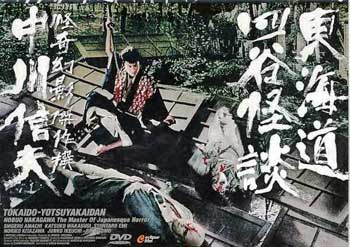 When he discovers what has been done to his family, he draws his sword to avenge Oiwa against her conspirators. But upon returning home, Oiwa's kimono comes alive & strangles him. When he discovers what has been done to his family, he draws his sword to avenge Oiwa against her conspirators. But upon returning home, Oiwa's kimono comes alive & strangles him.
By contrast Nobuo Nakagawa's visually stunning scope & color version makes Iyemon an extremely horrible man who kills people with great ease.
He kills Oiwa's father casting blame elsewhere, in order to marry her against her father's wishes. He lives a lazy life as a masterless samurai letting his wife support him making umbrellas, but after a hard pregnancy she becomes increasingly ill & unable to earn them a living.
Iyemon is offered a position on condition of marrying his boss's granddaughter. Assisted by his servant & Mephistopheles-like assistant Naosuke (Shuntaro Emi), they kill Oiwa (Kazuko Wakasuga), their infant child, & the masseur who was paid to attempt to seduce her.
Shigeru Amachi's performance as the evil husband is expressed with a terrible relish; it's easy to hate the bastard.
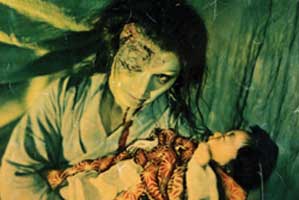 Horror is heaped upon horror in this violent tale. The lobby just above shows the corpses which were nailed to two sides of a door before being sunk into a pond. Horror is heaped upon horror in this violent tale. The lobby just above shows the corpses which were nailed to two sides of a door before being sunk into a pond.
The murder victims return as hideous apparitions seeking revenge. The production levels are high, the acting excellent. It's one of the more stylish versions with some genuinely creepy scenes, as is conveyed by the still of Oiwa with her ghost-infant.
In the kabuki play there is an infamous "hair combing" sequence which is reenacted in Nakagawa's film to the height of horror. It's an interesting aside that hair-combing sequences occur in many kabuki plays & are supposed to provide rather sexy tableaus of beauty, but in this play, hence this film, all the "buttons" intended to be pushed by such a scene are turned inside out.
Nakagawa is considered to have been Japan's first great horror director, & besides having provided perhaps the best version of the Yotsuya ghost story, he also directed Kaiden hebi-onna (Ghost Story of a Snake Woman, 1961), Jigoku (Sinners of Hell, 1960), Onna kyuketsuki (Lady Vampire, 1959), Kaidan Kasane-ga-fuchi (The Ghost of Kasane,1957), Borei kaibyo yashiki (Black Cat Mansion, 1958), & others for a truly impressive body of horror available on subtitled DVDs.
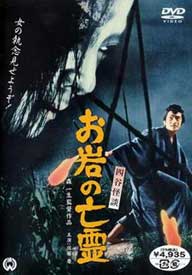 The version by Kazuo Mori (aka Issei Mori) is variously known as Curse of the Ghost aka Ghost of Oiwa aka Curse of the Night (Yotsuya kaidan: Oiwa no borei, Daiei, 1969). Mori is best remembered for having done episodes of Zatoichi, being one of the most competent if occasionally generic directors of chambara. The version by Kazuo Mori (aka Issei Mori) is variously known as Curse of the Ghost aka Ghost of Oiwa aka Curse of the Night (Yotsuya kaidan: Oiwa no borei, Daiei, 1969). Mori is best remembered for having done episodes of Zatoichi, being one of the most competent if occasionally generic directors of chambara.
About 1786 the doings of a demented lord results in many masturless samurai, including Iyemon (Kei Sato, who makes a wonderful bad guy) who is used to luxury & cannot adjust to the hand-to-mouth conditions & piecework of umbrella making. Having hired ruffians to make him look like a superior swordsman, he arranges for himself the opportunity of a profitable marriage.
He hires the half-blind masseur Takuetsu (Sawamura Sounosuke) to seduce or rape his wife (Kyoko Mikage), so that she can be divorced or killed for adultery. But the masseur takes pity & informs Oiwa of her husband's horrid plot.
Assisted by the merchant's daughter he intends to marry, Iyemon disfigures his wife attempting to poison her so he an marry higher. There's a lovingly gruesome sequence as she combs blad patches into her hair, kneeling deformed at her mirror, weeping with bitterness. She eventually cuts her own throat, swearing revenge. Her body & that of her infant vanish.
There are other plot threads in all these versions I've skimmed past, but it is worth noting that the story also features a character named Osode (Mikage Kyouko), Oiwa's sister. In Curse of the Ghost Osode & her boyfriend Shozaburo (Kimura Gen), a merchant & ex-samurai, attempt kataki-uchi blood vengeance for Oiwa, both of them armed with longswords (Osode unfortunately doesn't put on much of a show with hers), & are slain by Iyemon.
Soon Iyemon is being haunted & begins killing the people closest to him, including the young woman he had intended to wed. Each time he believes that he is defending himself from his wife's grotesque spirit. Iyemon flees the law but Oiwa continues the haunting until everyone who ever harmed her is killed.
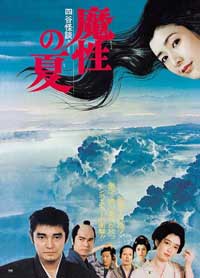 This by no means exhausts the versions that have been filmed, several of which from the pre-war era probably do not survive. This by no means exhausts the versions that have been filmed, several of which from the pre-war era probably do not survive.
After Kazuo Mori's version failed to be a box office hit, it would be a long time before the theme again reached the big screen. There was no film version done in the 1970s.
Then it was filmed by Yukio Ninagawa with Kenichi Hagiwara as the down & out samurai Iyemon, & Keiko Sekine (credited as Keiko Takahashi) as the ghostly Oiwa.
Called Summer Demon aka Summer of Evil (Masho no natsu: Yotsuya kaidan yori, Shochiku, 1981), I've not had the opportunity to see it & don't have any reports on its merits. A poster (mostly in blue, shown on the left) makes it look inappropriately upbeat.
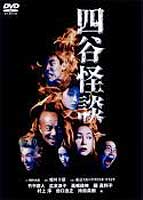 The same director released a filmed stage version as performed at theater Coccoon in Tokyo late in 2001 & early 2002. (Yotsuya kaidan yori, 2002) starred Naota Takenaka & Ryoko Hirosue in the central roles. The same director released a filmed stage version as performed at theater Coccoon in Tokyo late in 2001 & early 2002. (Yotsuya kaidan yori, 2002) starred Naota Takenaka & Ryoko Hirosue in the central roles.
This last ought to provide a grand opportunity to get an impression of what it would be like to see this story performed live. The DVD cover for this theater piece is shown here at the right.
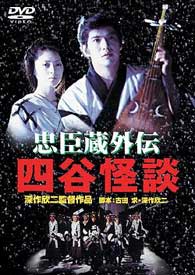 Kinji Fukasaku is probably best remembered for his yakuza films though he also made several fine examples of chambara. Kinji Fukasaku is probably best remembered for his yakuza films though he also made several fine examples of chambara.
His Crest of Betrayal (Chushingura gaiden: Yotsuya kaidan, 1994) is a hybridized tale that blends the legendare ghost of Oiwa (Saki Takaoka), with the historical story of the brave forty-seven ronin. It takes clever advantage of the fact that the historical tale & the ghost story were set in the same place & era.
In Fukasaku's rather lavish film, based on a novel by Tsurumi Shunsuke, Iyemon (Koichi Sato) is an amibiguous hero, not the relentless tormenter of his wife as in the usual versions. Iyemon is almost as badly victimized as innocent Oiwa. He & his wife's ghost have enemies in common with the brave 47 ronin, & so assist key figures of the Chushingura tale in their quest for revenge.
Yotsuya ghost story continues to inform the latest generation of J horror wherein it remains de rigour to depict ghostly women with long hair half hiding their disfigured faces & dripping wet from head to toe. In the golden age of Japanese cinema (the 1950s & 1960s) many other stories were told about supernatural women in the age of samurai, including most popularly in Masaki Kobayashi's Kwaidon, Kaneto Shindo's Kuroneko & Onibaba, several from Nobuo Nakagawa "the James Whale of Japan," & many others, with a tendency toward a startling level of artistic quality as well as of eeriness.
For discussion of similar kinds of Japanese horror films, see the companion articles on Ghost Cats & Blind Masseurs & More Bakeneko-mono Ghost Cat Films.
copyright © by Paghat the Ratgirl
|
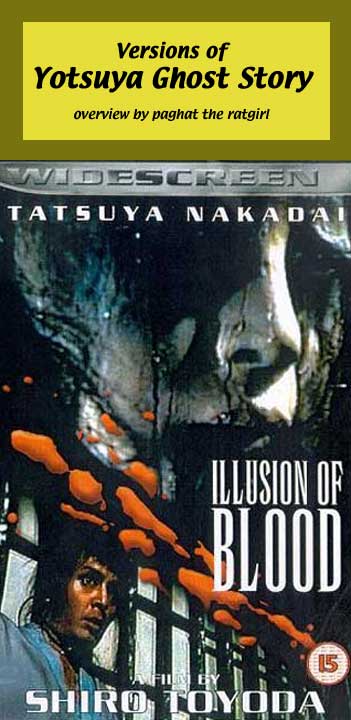
 Period ghost stories are an important genre in Japanese cinema. The conventions of the genre are inherited from traditional storytellers & folklore classic kabuki plays, most famously Tokaido yotsuya kaidan by the classical kabuki playwright Namboku Tsuruya IV (1755-1839), in which a horrific & pitiful murdered woman returns to avenge herself against her cruel husband. This was standard summertime entertainment in the late Tokugawa period, intended to "chill" the audience during the hottest days of the year.
Period ghost stories are an important genre in Japanese cinema. The conventions of the genre are inherited from traditional storytellers & folklore classic kabuki plays, most famously Tokaido yotsuya kaidan by the classical kabuki playwright Namboku Tsuruya IV (1755-1839), in which a horrific & pitiful murdered woman returns to avenge herself against her cruel husband. This was standard summertime entertainment in the late Tokugawa period, intended to "chill" the audience during the hottest days of the year. The majority I would guess do not survive. Except for Daisuke Ito's film, most of the silent versions would have, in any case, provided only a few pictorial clues for the benshi (silent film narrator) who presented these films to convey their own storytelling prowess.
The majority I would guess do not survive. Except for Daisuke Ito's film, most of the silent versions would have, in any case, provided only a few pictorial clues for the benshi (silent film narrator) who presented these films to convey their own storytelling prowess. Furumi Takuji directed an early talkie version in 1936 & Onoe Eigorou directed another in 1937.
Furumi Takuji directed an early talkie version in 1936 & Onoe Eigorou directed another in 1937.
 Tomisaburo Wakayama starred in yet another version, Ghost of Oiwa (Kaidan Oiwa no burei, Toei, 1961), with Fujishiro Keiko as Oiwa. Directed by Yasushi/Tai Kato, this is one of the most vile & brutish evocations of Iyemon's character.
Tomisaburo Wakayama starred in yet another version, Ghost of Oiwa (Kaidan Oiwa no burei, Toei, 1961), with Fujishiro Keiko as Oiwa. Directed by Yasushi/Tai Kato, this is one of the most vile & brutish evocations of Iyemon's character.
 When he discovers what has been done to his family, he draws his sword to avenge Oiwa against her conspirators. But upon returning home, Oiwa's kimono comes alive & strangles him.
When he discovers what has been done to his family, he draws his sword to avenge Oiwa against her conspirators. But upon returning home, Oiwa's kimono comes alive & strangles him.  Horror is heaped upon horror in this violent tale. The lobby just above shows the corpses which were nailed to two sides of a door before being sunk into a pond.
Horror is heaped upon horror in this violent tale. The lobby just above shows the corpses which were nailed to two sides of a door before being sunk into a pond.

 The same director released a filmed stage version as performed at theater Coccoon in Tokyo late in 2001 & early 2002. (Yotsuya kaidan yori, 2002) starred Naota Takenaka & Ryoko Hirosue in the central roles.
The same director released a filmed stage version as performed at theater Coccoon in Tokyo late in 2001 & early 2002. (Yotsuya kaidan yori, 2002) starred Naota Takenaka & Ryoko Hirosue in the central roles.